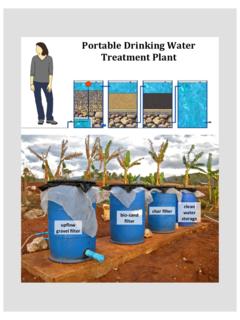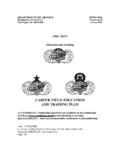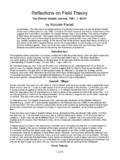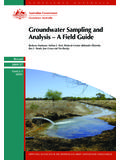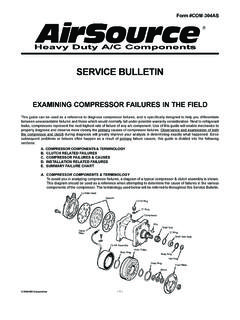Transcription of Simple Field Tests for Water Quality
1 Simple Field Tests for Water Quality By Josh Kearns January 2008. This document describes the procedures and equipment needed to conduct three Simple Water Quality assessments in the Field : measuring turbidity and dissolved iron concentration, and detecting the presence of potentially harmful microbial contaminants. ( testing for pesticides in source waters requires sophisticated laboratory equipment and specialized chemical reagents that are not readily available and are expensive and thus beyond the capabilities of on- site analysis.). Measuring turbidity1. Turbidity (cloudiness owing to suspended solids and/or organic matter) in the source Water may cause clogging of sand and charcoal filtration units. Turbidity also reduces transmittance of UV light through Water and thus markedly reduces the effectiveness of UV disinfection. Suspended particles in the Water absorb UV energy or shadow microbes from the UV radiation.
2 If turbidity is too high, Water passing under the lamp may not receive the minimum dosage necessary to inactivate microbial contaminants. There are several ways of quantifying turbidity in Water , the most common being some measure of the attenuation (reduction in strength) of light as it passes through a column of Water . Electronic turbidity meters are the most precise; however, they are expensive. A turbidity tube is inexpensive and easy to construct, and provides an approximate measurement of turbidity with sufficient accuracy for Field Water Quality assessments. A turbidity tube can be readily constructed using clear tubing (glass or plastic) 3 4 cm in diameter (~1 ! - 1 " in.). and ~ 70 cm (~ 28 in.) in length. The tube is capped at one end with PVC or plastic and sealed with silicone. A. Secchi disk is drawn on the inside of the cap using waterproof marker or black and white paint as shown: Page 1 of 6.
3 Simple Field Tests for Water Quality The tube is marked along its length according to the scale: Distance Turbidity cm NTU. 500. 300. 200. 100. 50. 19 30. 25 20. 10. 63 5. NTU stands for Nephelometric Turbidity Unit, a common unit for recording measurements of turbidity. Sand filters can accommodate occasional turbidity up to 50 NTU without excessive clogging; however, average turbidity over time must not exceed 20. 25 NTU to avoid frequent clogging problems. Allowing source Water to stand for several hours permits particles to settle out, reducing turbidity. Also, an upflow roughing filter using coarse media such as pea gravel can be used to remove excess turbidity. Source Water must have turbidity no greater than 5 NTU for disinfection by UV radiation to be effective. To measure turbidity, slowly add sample Water to the tube and record the depth (in cm) at which the Secchi disk becomes invisible.
4 It is helpful to stand with your back to the sun and rotate the tube as you look for the lines of the disk. Avoid creating bubbles when pouring Water into the tube as these interfere with accuracy. Rough estimates of turbidity in NTU can be read directly off the tube using these calibrated markings. More precise estimates can be made by imputing distance measurements (in cm) into the following equation and solving for turbidity: log(T) = (d) + where T is turbidity in NTU and d is distance in cm. Page 2 of 6. Simple Field Tests for Water Quality Empirical relationship between turbidity and visibility distance. Measuring dissolved iron concentration2. Excess iron in Water used for drinking, cooking and washing imparts unappealing color and taste, and reduces the effectiveness of UV disinfection by impairing transmittance of UV light through Water . If the amount of iron in a Water supply is above the US EPA and World Health Organization guideline of mg/l ( ppm), the Water can cause staining of laundry or discoloration of faucets and basins.
5 However, even high concentrations of iron are not considered a health problem. Simple , inexpensive iron Tests are commercially available in most places. The SenSafe Iron Check kit (catalog number 480125 ITS) is available from Industrial Test Systems (1-800-861-9712, ), costs about US $25 (inc. s/h within the US), and includes 30 test strips. If the source Water has iron concentration greater than the US EPA and World Health Organization guideline of ppm ( mg/L) then pretreatment is necessary to ensure complete UV disinfection. A slow-sand filter is an effective means for precipitating excess iron from solution. Page 3 of 6. Simple Field Tests for Water Quality Detecting microbial contaminants Of primary concern among the wide variety of potential microbiological contaminants of drinking Water are fecal coliforms. Fecal coliforms are present in the intestinal tracts of all mammals and frequently are detected in environmental waters exposed to feces.
6 Although most fecal coliforms are not harmful to humans in small concentrations, many coliforms at high concentrations can cause a variety of diseases such as typhoid fever and dysentery. Furthermore, some coliforms, such as strain 0157-H7, can be deadly even at low concentrations. Direct testing for bacterial pathogens is often impractical and requires lengthy and complex test procedures, making the use of indicator organisms routine. Indicator organisms are present when pathogens are present and absent when pathogens are absent. Indicator species are usually of fecal origin, though themselves are usually not pathogenic. Hydrogen sulfide-producing bacteria are often associated with the presence of fecal coliforms and thus can be used as indicator organisms. Hydrogen sulfide (H2S) is a gas that reacts with iron in solution to form iron sulfide, and insoluble black precipitate.
7 This precipitate is easily visible and thus is taken to indicate a positive test. Care must be taken in the interpretation of test results as a number of conditions can result in a false positive result. The test detects the presence of H2S even if it is not produced by organisms of fecal origin. False positive results for fecal contamination in H2S Tests can come from a number of sources, including the presence of sulfides of non- biological origin and from the activities of microbes of non-fecal origin. H2S can be produced in the environment via abiotic chemical reactions, and also by non-fecal organisms associated with biological sulfate reduction. Sulfate reducing bacteria are a ubiquitous group of environmental bacteria that produce H2S and occur in a variety of habitats, including marine and freshwaters and their sediments, soils, biofilms, intestines of animals and fish, termite guts, and geohydrothermal environments ( , hot springs, subsurface and submarine hydrothermal vents, etc.)
8 H2S. also is produced by the decomposition of amino acids and other organic forms of sulfur in biomass, and through microbially-induced corrosion of iron, steel and other metals often associated with Water sources, treatment systems, conveyances and storage facilities. These are all widespread phenomenon in many environments and are carried out by many different kinds of microorganisms not necessarily of fecal Although there is significant probability of the H2S test giving a false positive result, a false negative result is unlikely owing to the sensitivity of the test. In addition to the hydrogen sulfide-producing bacteria Salmonella, Citrobacter, Proteus, Edwardsiella, and some species of Klebsiella, the H2S test can also detect some bacteria other than coliforms that are associated with fecal contamination, including Clostridium perfringens, which is one of the more resistant indicators of fecal contamination and can be found in drinking waters even when no coliforms can be found.
9 Therefore it is possible for the H2S test to give a positive result when fecal contamination is present even if no coliforms are Accordingly, a negative test result lends strong confidence that the Water source in question is free of fecal contamination. Page 4 of 6. Simple Field Tests for Water Quality The H2S test method does not detect viruses or parasites. A source for inexpensive, commercially available H2S Tests is the PathoScreen Field Kit, distributed by the Hach Corporation (catalog number 28591-00, ). The PathoScreen kit costs about US $55 (inc. s/h within the US) and includes materials for 100 Tests . The sample bottles are first sterilized with 6 % bleach solution and then rinsed several times with the sample Water before collecting the sample. The media is then added this is an iron-containing growth substrate for the hydrogen sulfide-producing indicator bacteria.
10 Microbial presence/absence test procedure: (1) sterilize the sample bottle; (2) rinse the sample bottle several times with the Water to be tested; (3) take the sample and add the media. 2. The sample is then incubated at 25 35 o C for 24 48 hours. Microbial metabolism slows down below 25 oC and thus may result in a false negative indication if incubation temperature is too low. Temperatures above 35 oC may inactivate target organisms, also resulting in a false negative outcome. A Simple incubator can be constructed out of a cardboard box fitted with a thermometer, using a low-wattage incandescent light bulb as the heat source. Flaps are cut in the cardboard box that can be opened and closed as needed to regulate incubation temperature. Page 5 of 6. Simple Field Tests for Water Quality (4) Incubate the sample at 25 35 o C for 24 48 hours; (5) Observe formation of a black precipitate.
